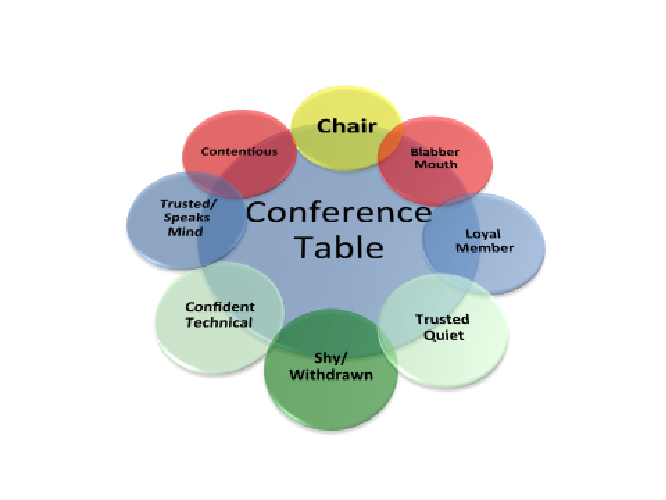How many of you have walked into a meeting where you are the chair or moderator and followed a seating plan? None? Probably most of us have no seating plan. We walk in, take the seat that we think is the head of the table, and the participants filter in and sit where they choose. Depending on power, interest, friendship and personality they will choose to sit close to you or as far away as they can get. If this is what has happened, you have abdicated one of your most powerful control/influence tools before a word has even been spoken. Why? Because we probably never considered it important, and to the extent we did, we did it wrong anyway.
To the extent that we have any plan at all, it probably involves keeping our supporters and friends close and our adversaries/enemies as far away as possible. This is precisely the opposite of what we should be doing. Remember The Godfather adage—keep our friends close and our enemies closer. But the reasons for this tactic in a business meeting have less to do with trust and danger than they do with the power of physical architecture. Simply put, how people are placed around the table has a great deal to do with how much power you, as the chair, have over the proceedings. In a similar way, the shape of the table is important too—for those of you of a certain age, you will remember the Vietnam peace negotiations where the proceedings were delayed for months while they debated the shape and arrangement of tables (the North Vietnamese wanted a round table, so that all parties were equal). But table shape will have to wait for another column on another day.
The importance of meeting architecture here is anchored in two physical limitations of the human body. The first limitation is based on the narrow line of sight our eyes have as compared to the much wider peripheral vision. If you spend a little time experimenting with the kind of detail you can make out with peripheral vision, you will realize how limited it is. This means that we can only focus on a narrow range in front of us. In a sense, when you are focusing on one person, you are not focusing on anyone else. It can’t be done.
The second limitation is that our body can only be rotated in one direction at a time. When we face one person we turn our back on others. If one person at the table is dominating the conversation and you are listening to them, then someone else is spending a lot of time looking at your back. For all you know, they are making faces at you.
And don’t even get me started on listening to two conversations simultaneously—it cannot be done. This issue was settled in 1953 in an experiment at a cocktail party (Cherry, 1953). Participants in one conversation were asked to eavesdrop on a second conversation. Try it sometime; you will find yourself nodding to the people in one conversation while actually listening to the other.
But the purpose of this column is not to bemoan our limitations, but to figure out how we can use them to our advantage in a meeting. As the graphic below will show, much of the advantage comes in how we place people around a table (I have depicted a round one here).
The graphic above shows that we have placed the contentious and voluble people next to us, with the quietest people placed farthest away, and the trusted participants in between. The reasons are based on our physical limitations.
First the shy person: We place them opposite us because they will be in our direct line of sight. Since they are unlikely to speak up unless called on, we have to be visually aware of non-verbal signals. When we see these cues we can “invite” them to share their thoughts. If they were only in our peripheral vision we would never see these cues, and we would miss their participation. Often the quietest people have the most thoughtful contributions.
Second the naysayers and blowhards: We place them right next to us so that we can control them. The control comes partially from the fact that they are not in our direct line of sight; so we cannot accidently invite them in the conversation. We can also use the power of our body orientation. If one of them is dominating the conversation we have two physical options to quiet them down:
- You can spin yourself so that you directly face them and enter their personal space. With the rest of the room excluded they lose their audience and their power. You can thank them for their comments and spin back to the rest of the table.
- The second option is to spin your chair the other way and give them your back while you start a conversation with others. It is not very pleasant to speak to someone’s back.
The rest of the people around the table need less care and feeding. They are the trusted, loyal compatriots who will participate, but you need not “manage” them.
The last problem is how you get them to sit where you want them. This is a stickier issue. The process is proximate and the results imperfect. First, ask your loyal lieutenants not to sit next to you. Second, invite the troublemakers to sit next to you (that in itself will confuse them). With those seats taken you have some chance that the quiet people will be facing you.
It may not be place cards a la Emily Post, but it’s a start at structuring a meeting to go as you wish.
References:
Cherry, C. (1953). Some Experiments on the Recognition of Speech with One and with Two Ears. Journal of Acoustic Society of America, 975-979.






